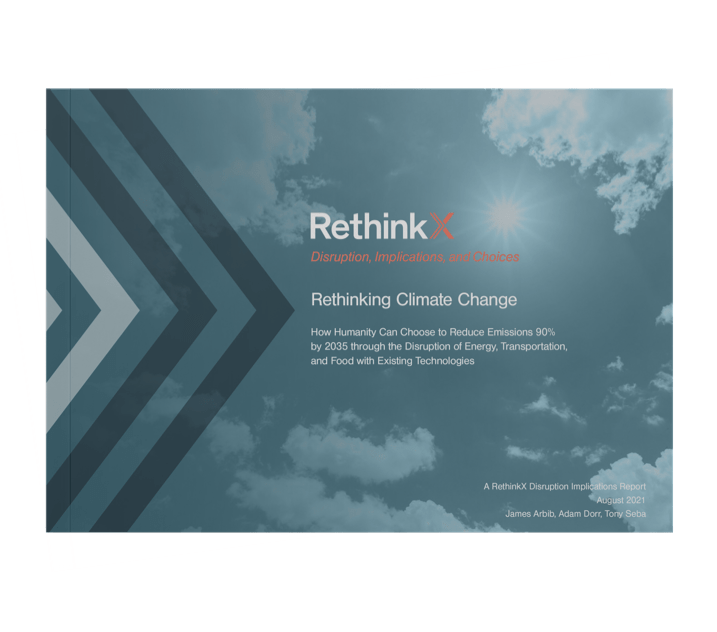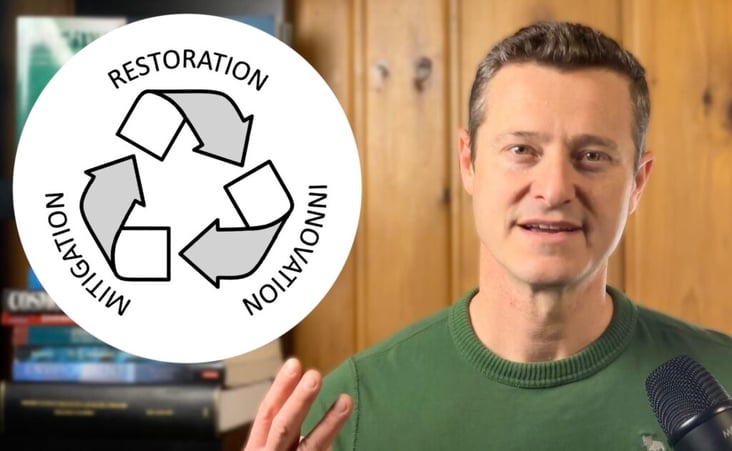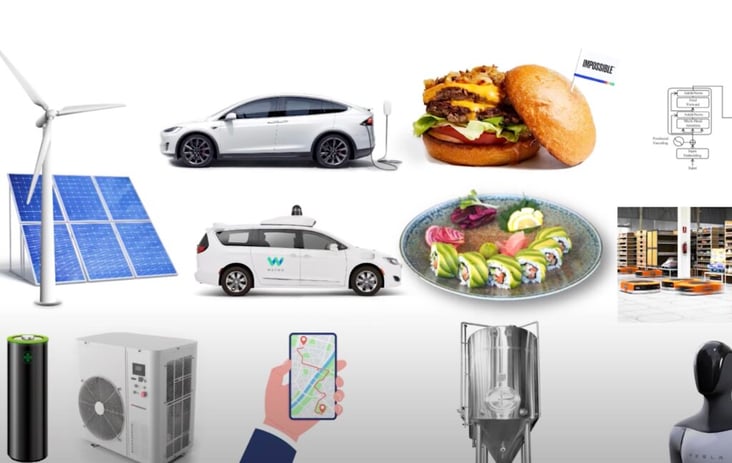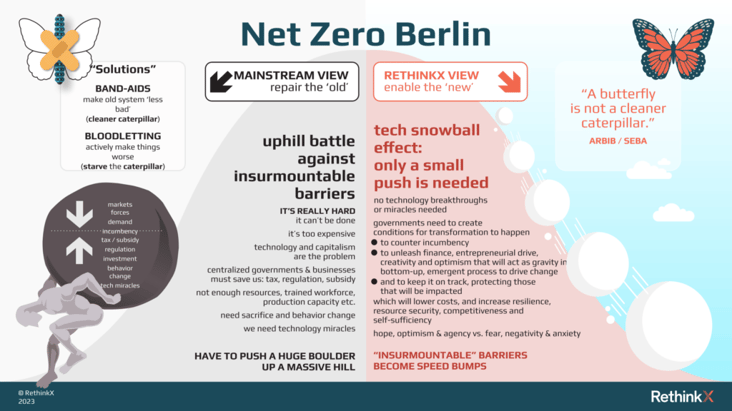Topic / Climate Implications / In-depth
Eight technologies, Three Disruptions, and 90% Emissions Reduction by 2035
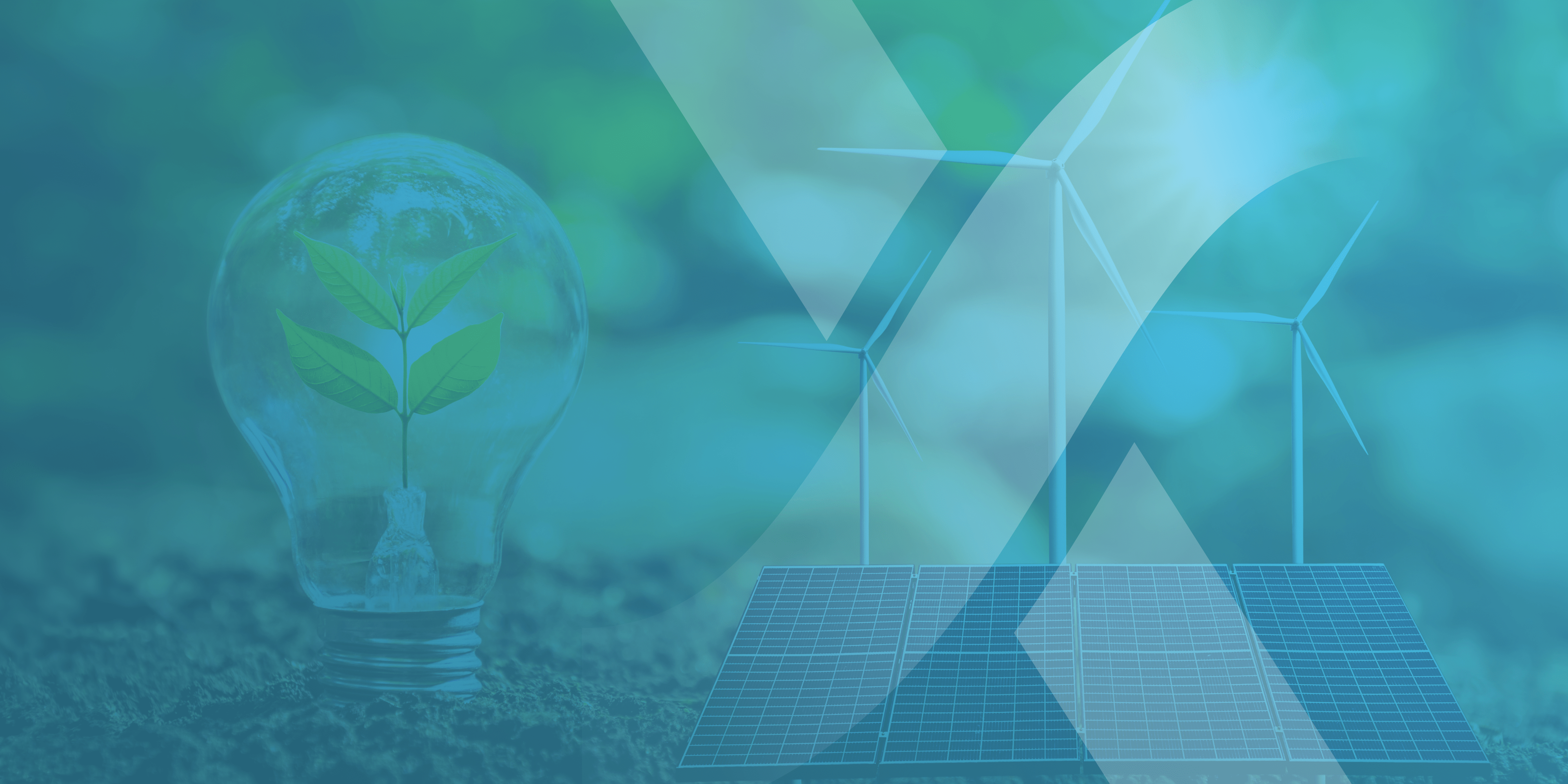
By embracing technology disruptions across our energy, transportation, and food & agriculture societies can:
-
directly eliminate over 90% of net greenhouse gas (GHG) emissions worldwide within 15 years
-
reach net zero emissions before 2040
-
lay the groundwork for a complete solution to climate change
-
save trillions of dollars
-
and improve prosperity and quality of life worldwide...
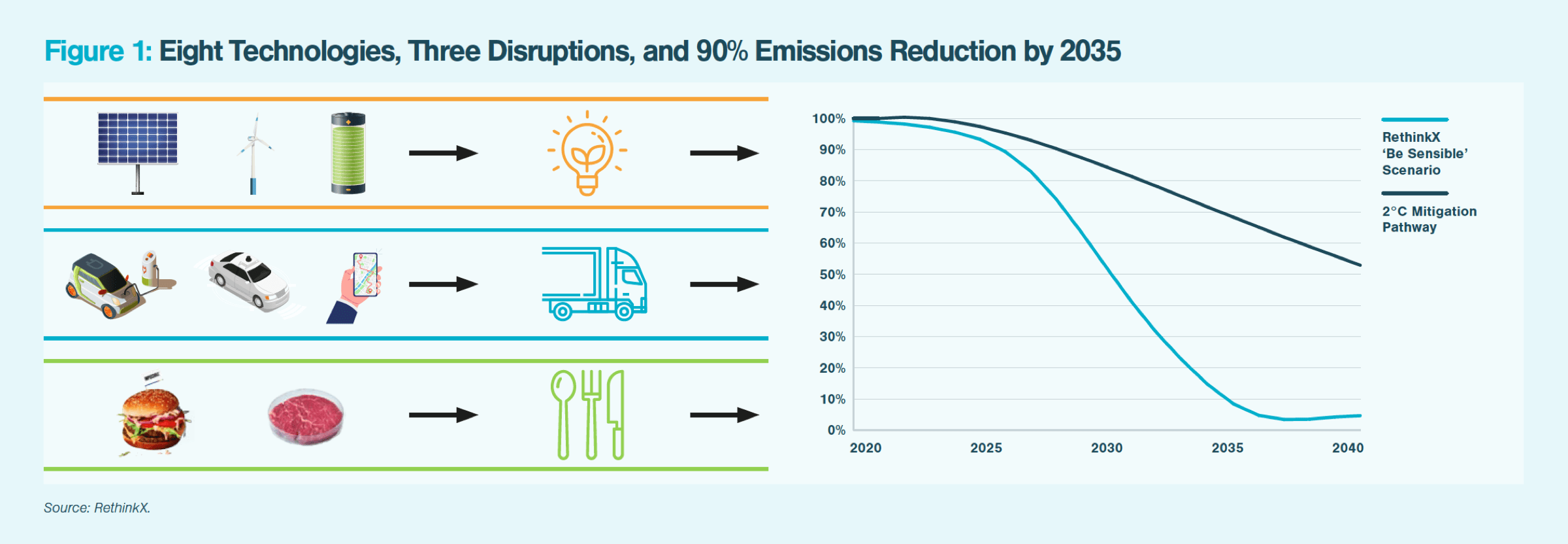
The climate implications of the energy, transportation, and food and agriculture sector disruptions are far-reaching.
Key Implications:
Reach net zero faster
We do not need fusion power or other major unproven breakthroughs. The technologies we need already exist and can help us achieve net zero emissions faster.
We only need to deploy and scale solar, wind and battery power, electric and autonomous vehicles in the form of Transport-as-a-Service, and Precision Fermentation and Cellular Agriculture as quickly as possible and we could eliminate over 90% of our global emissions by 2040.
Reach net zero without economic or social damage
The energy, food and transportation disruptions will rapidly disrupt older, dirtier industries through market forces alone.
This means we are not dependent on governments to impose draconian restrictions on either the supply or the demand side of the economy, which in turn means we can avoid the social harms of austerity policies.
Decarbonizing the economy will save trillions of dollars
Emerging disruptive technologies will continue to become cheaper as their adoption accelerates, while costs and capabilities improve with scaling.
By leveraging the power of market forces, decarbonization can be transformed from a costly expense into a lucrative investment at every scale, from local to global.
Focus our approach to emissions reduction
The most effective emissions reduction approach is to concentrate on a single strategy: deploy and scale existing technologies.
The evidence to date indicates that it is counterproductive for societies to divide their time, attention and resources among a large number of different emissions reduction strategies. The most effective approach is to focus on deploying and scaling existing technologies to disrupt the energy, transportation and food sectors as quickly as possible. This will mitigate most emissions and make carbon withdrawal through both reforestation and technology-based approaches more affordable.
Balance environment with economy
Emerging disruptive technologies represent a major step toward the ultimate goal of meeting human needs sustainably.
Until now, economic growth and human development has come at the cost of the environment. Disruptive technologies will transform the relationship between the environment and the economy into a win-win relationship, by closing the emissions loop entirely and preventing a Jevons paradox from occurring.
Narrow the wealth gap
Disruptive technologies will accelerate human development and raise the standard of living in poorer and less-developed communities by reducing the cost of living.
These new technologies will transform geopolitical relations by eliminating geographic advantages and disadvantages, such as scarce deposits of fossil fuels or winter food storage challenges. They will also enable more radical localization, as a new decentralized production system based on creation from superabundant local resources supplants the old centralized system.
Enable affordable carbon withdrawal
Today the scope and cost of carbon removal seem overwhelming. But the same SWB and A-EV technologies that will disrupt the energy and transportation sectors will also drastically reduce the cost of carbon withdrawal.
Active reforestation, ocean alkalinity enhancement (OAE), direct air carbon capture and storage (DACCS), and other carbon withdrawal methods are all costly because of their energy, machinery and labor requirements. SWB Superpower, electric vehicles, automated vehicles and machinery that runs on clean energy and does not require human operators will make carbon withdrawal more affordable.
The greatest barrier to fighting climate change is our mindset
The prevailing narrative assumes we can solve the problem within our current system. However, current solutions are intertwined with outdated modes of production.
We cannot solve climate change by making our existing system ‘less bad’, we can only solve it by disrupting and transforming the system itself.
How have conventional approaches to emissions reduction wasted our time, attention and resources?
Solving problems within a failing system
We are in the midst of a phase change disruption. The old rules don't apply.
Unless we plan for a future that embraces the coming clean disruptions, we will fail to solve our most pressing global problems.

Investing in band-aid approaches
Band-aid approaches to climate change will never solve the crisis.
Solutions like subsidies and taxes, biofuels, clean coal and clean diesel are superficial techno-fixes that treat symptoms rather than the underlying problem.

Wasted focus on de-growth
We cannot possibly reduce production and consumption to zero, and getting even halfway there would cause unimaginable human suffering.
De-growth will disproportionately impact poor communities and less-developed nations, and wipe out the financial, social and political capital required to build a truly sustainable energy, transportation and food system based on clean technology.

Wasted focus on austerity measures
By focusing on symptoms rather than root causes, conventional approaches to fighting climate change through austerity are not just futile but actively counterproductive.
RethinkX's research on disruption provides a guide for decision-makers on how to make the best choices to reach net zero.

Inevitable disruptions across energy, transport and food & agriculture will transform our global systems and directly address our climate problems.
The only answer is to embrace and accelerate clean disruption
The conventional approach has ignored the inevitability of these intersecting disruptions and has instead tried to decarbonize our global economy incrementally through a wide variety of failed techniques, policies and technologies.
Like medieval doctors prescribing bloodletting, these treatments won't fix the problem. Instead, they will make solving the problem harder and create new problems in the meantime.
By failing to fully appreciate disruption & systems dynamics, conventional models have underestimated both the threat of climate change and the potential of technology to address it.

The RethinkX guide to emissions reduction
A far better approach is to focus on the technology disruptions of the three foundational sectors of the global economy that are together responsible for over 90% of greenhouse gas emissions.
The combined impacts of the energy, transportation and food disruptions will open up unprecedented opportunities to mitigate carbon emissions and draw down carbon from the atmosphere.
While disruptions of the energy, transportation and food sectors are inevitable, they might be delayed or accelerated depending on the choices made.
The exact timeline of these disruptions—and thus our exposure to climate change risks—still depends on our societal choices.

Disruption supports ecological restoration
The disruptions of energy, transportation and food will trigger the greatest reduction of humanity’s ecological footprint in history.
The economic competitiveness of SWB, A-EVs and TaaS, and PF and CA technologies will decimate the fossil fuel, animal agriculture and commercial fisheries industries worldwide. This will extinguish some of the drivers of air and water pollution, soil contamination and loss, deforestation, marine plastic pollution, and terrestrial and aquatic biodiversity loss.
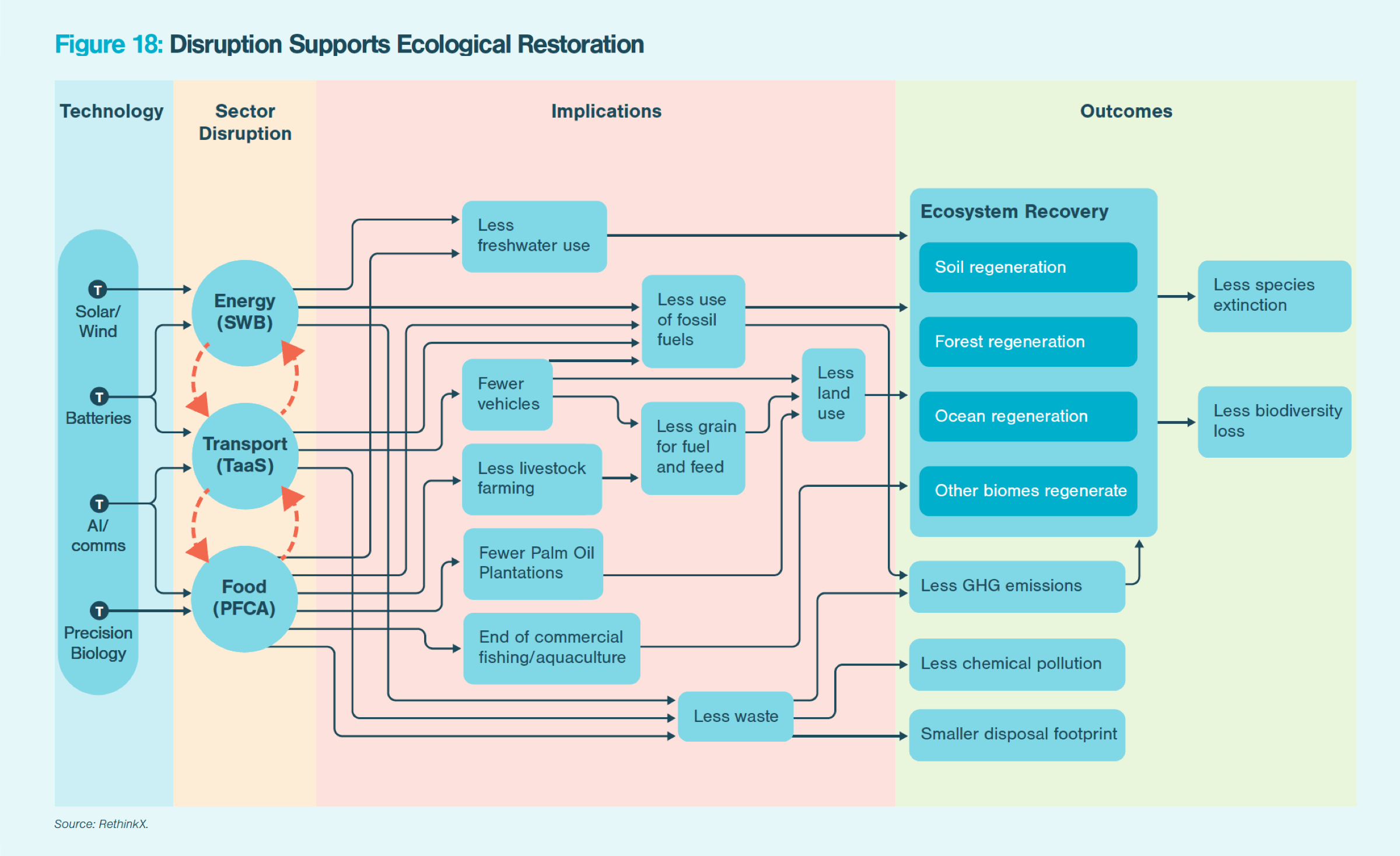
Climate choices for decision-makers
We can solve the climate crisis by ushering in a new era of clean prosperity—or we can waste time and trillions of dollars propping up the current system that exposes humanity to greater climate change impacts.
Despite the tremendous opportunities that the clean disruption of energy, transportation and food will bring, technology alone is not enough. Societies around the world must make the right choices.
In our Rethinking Climate Change Report, we help decision-makers understand these choices by categorizing sources of emissions according to three stages of mitigation readiness: research, deploy and scale.

Did you Know?
The Future of the Environment is Brighter than you think
Join RethinkX Director of Research Adam Dorr in our new video series ‘Brighter’ where he uncovers why clean technologies will transform our relationship with the natural world...

